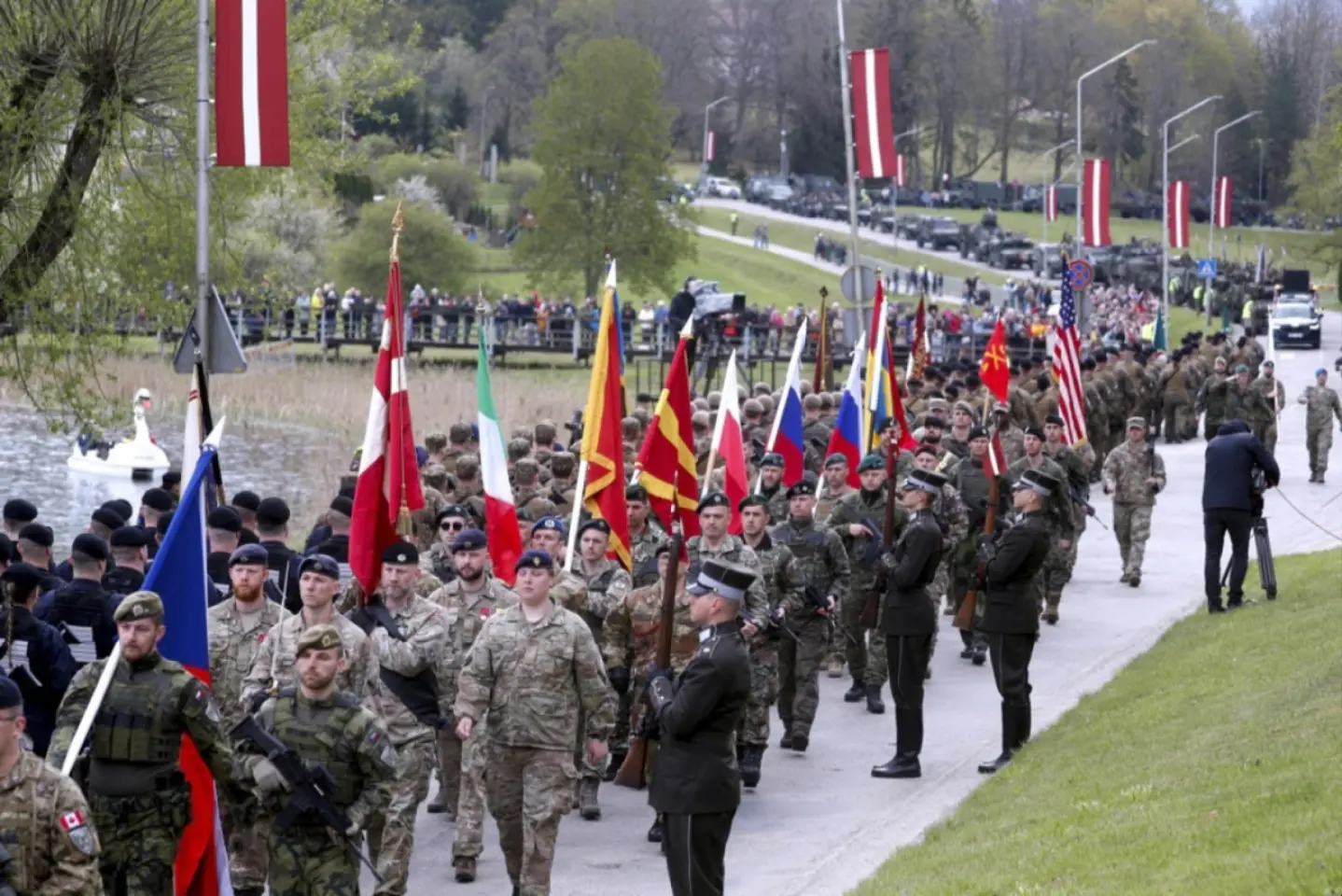
Lithuania, Latvia, and Estonia have always been vulnerable to a Russian attack. Individually, each of them would be relatively easy prey for their enormous southern neighbor, which has vastly superior military, economic, and human resources.
The Baltic states’ integration into NATO has brought them unprecedented security guarantees, but threats persist. Experts have long warned that if Russia were to test NATO, it would most likely do so by attacking one of the Baltic states. Their relative geographic isolation from the rest of the Alliance—the only land link is through the Suwalki Gap – and their limited military capabilities make them tempting targets. Isolation means that it would take time for aid to arrive, and their reduced military capacity means that their armies may not be able to provide this time.
Faced with the uncertainties generated by Russian aggression, NATO decided to strengthen its forces in the Baltic States, and the Alliance's strength in the region has increased considerably with the accession of Finland and Sweden, which abandoned their neutrality also because of the Russian threat.
However, Donald Trump's arrival in the White House has generated new concerns for the Baltics, given that there are now question marks over Washington's willingness to intervene forcefully to save a European ally. Against this background, in Latvia, more and more voices argue that the Baltic States should rely more on their own forces and on the states in their immediate vicinity. An important step would be to intensify military cooperation between the Baltic States, to a level at which their security is addressed as a whole, not for each individual.
The Baltic States Military Alliance, a Century-Old Idea
The awareness that the Baltic states should cooperate in defense and, possibly, attract other countries, existed even after World War I. In 1920 and 1921, Latvian Army General Pēteris Radziņš called for the formation of a close alliance of these states, as he was aware that none of them had the strength to face their much more powerful and larger neighbours – especially the one to the South. That never happened, and the Baltic statese would be easily swallowed by the Soviet Union.
The Baltic States have cooperated in many formats since the fall of the Soviet Union. All three countries share a common geographical region, historical context, and potential battlefield enemy - Russia. The populations and, consequently, the size and capabilities of their armies are also relatively similar.
One of the formats for cooperation is the NATO alliance. In it, the Baltic states cooperate with other NATO member states. Since 2014, when Russia invaded Ukraine, permanent military missions have been deployed in Poland and the Baltic states. In Poland, it is led by the USA, in Estonia - by the United Kingdom, in Lithuania - by France, in Latvia - by Canada. Soldiers from other countries also participate in the missions. The soldiers from Albania, North Macedonia, the Czech Republic, Denmark, Sweden, Italy, Spain, Poland, Montenegro, Slovakia, Slovenia, and Iceland regularly stay in Latvia. From time to time, international military exercises take place in one of the Baltic countries. Their task is to promote regional cooperation. Also, NATO centres of excellence have been set up in the region. Latvia has a NATO Strategic Communications Centre of Excellence, there’s an Energy Security Centre of Excellence in Lithuania, and a Cybersecurity Centre of Excellence in Estonia.
There are also some regional initiatives. For example, in 2024, the Baltic states signed an agreement on the Baltic Defense Line. It develops policies on how to defend the Baltic states in the event of a military invasion. Since 1998, the Baltic States have established a naval cooperation called “Baltron”. There is also the Baltic Defence College (BALTDEFCOL), cooperation with the Nordic countries, called NORDEFCO.
More recently, as Latvia faced a flood of illegal immigrants pushed towards the border by Belarsus and Russia, Estonia stepped in to help.
In parallel, the Baltic states are increasing their national military budgets. The largest amount of funding in Latvia’s history has been allocated to defense in 2025 – more than 1.5 billion EUR, or 3.45% of the gross domestic product. More than 1.7 billion EUR (3.73% of GDP) was planned for defense in 2026, 1.8 billion EUR (3.69%) in 2027, and 1.6 billion EUR (3.15%) in 2028. However, even those figures could increase, as the government pledged to allocate at least 4% of Latvia’s gross domestic product (GDP) for defense next year, and to spend 5% of GDP on these expenses in subsequent years. For comparison, Lithuania will spend 5% on defense from 2026, Estonia - more than 4%.
The Baltic States also cooperate with other nearby countries. For example, a military vehicle factory built by the Finnish state-owned company “Patria” and the Norwegian company “Kongsberg Defence & Aerospace AS” was opened in Latvia in 2024.
The security of the Baltic States is also strengthened by the accession of Finland and Sweden to NATO in 2023. Thus, the Suwalki region on the Lithuanian-Polish border between Belarus and the Russian exclave of Kaliningrad is not the only territorial connection with NATO countries. Therefore, the Baltic Sea is becoming a second corridor connecting the Baltic and the rest of the alliance.
There is also talk in the West about the threat to the Baltic States. Now and then, one can hear a European politician, expert, or intelligence representative say that a direct and conventional Russian attack on NATO is inevitable, and the first target will be the Baltic States.
Such warnings have been heard for a few years now. Latvian experts, such as National Defense Academy lecturer Toms Rostoks, have linked these quotes to the need for Western politicians to justify to their societies why defense spending should be increased.
Expert: the ideal model of Baltic cooperation is “wishful thinking”
Military analyst Mārtiņš Vērdiņš points out that, ideally, the Baltic armies should have a joint general staff. This would mean that the multinational forces in Latvia would be led by officers from the Baltic states on a rotational basis. “Procurements would also be coordinated, looking at which country needs which weapons more,” says Vērdiņš. This would balance the entire defense of the Baltic States, because the equipment or weapons purchased by one country could be used by the other two. From a financial point of view, such an approach would be more fruitful because purchasing military equipment is expensive. In this case, it would also be easier to maintain the same model of military equipment. A soldier from one country could use the equipment of another country without any problems, and no new training would be required.
Vērdiņš adds that, until they buy the necessary equipment, the Baltic states should try to obtain it – possibly by renting it – from other NATO allies. In this way, the Baltic states would be better prepared for a military invasion at an earlier date.
However, Vērdiņš himself calls the idea of a single general staff “wishful thinking”. It is impossible for several reasons. “First, politics: giving one’s own armed forces for planning outside one’s own country is a blow to sovereignty,” he points out. For example, Latvian soldiers may be subject to the orders of generals from other Baltic states. Second, is it legally possible? Development plans would become transnational, which may contradict NATO policies. Third, financially, politicians want to control the finances that the state invests in the army. The existence of the “Baltic army” would reduce politicians’ ability to control financial flows.
Of course, in case of a war all these considerations that are now making a single general staff virtually impossible may be tossed aside, Vērdiņš says. “If it becomes a matter of life and death, then legal and other issues will become unimportant. Then decisions will need to be made faster”.
Latvia lags in terms of the number of soldiers
Latvia does have a problem, compared to its Baltic neighbors – a relatively low percent of citizens with military training. The country only restored the Soviet era compulsory military service in 2023, while Lithuania did it in 2015, and Estonia never abolished it.
According to the information provided by the Latvian army, it has almost 7900 soldiers. There are also about 10,000 national guardsmen who are also ready for armed conflict and 38,000 reserve soldiers and trained reservists. Vērdiņš estimates that the real number of reserve soldiers and training reservists who are really ready for combat situations is about 8000. Estonia, which has been preparing its reserve for a long time, has 4,200 active duty soldiers and 40,000 reservists – but the total number of Estonians with military training or that would have various military obligations in case of a conflict is 230,000. Lithuania has more professional soldiers - about 12,000 and fewer national guards, a total of about 23,000.
Mārtiņš Vērdiņš doubts that the Baltic governments could count on the help of the residents of the eastern Estonian and Latvian cities of Narva and Daugavpils in a critical hour. Both are relatively large cities, located close to Russia and, in the case of Daugavpils, also to Belarus. The majority of them speak Russian, and the discussions about which side the residents of these cities would take have been long.
Some good news: the Baltics are no longer that isolated
For years, the Achille’s hill to the collective defense of the Baltic states has been the Suwalki Gap, the narrow strip that connects the Baltics with Poland, and has Belarus on one side and the Russian enclave of Kaliningrad on the other. Mārtiņš Vērdiņš points out that the Gap could be easily cut down: “it is not necessary to occupy the Suwalki Gap by soldiers at all, because both roads and the railway line (that connects Lithuania and Poland) can be covered with artillery fire from Belarus and Kaliningrad”. However, the Gap has become less of a vulnerability since Finland and Sweden joined NATO, as they could help compensate via the Baltic a cut in supplies and troops.
Vērdiņš also urges the Baltic politicians to offer the West more practical cooperation than values. It should be beneficial for the West to support the Baltic States. From this point of view, they could be interested in the Baltic ports as a point from which to explore the Arctic.


